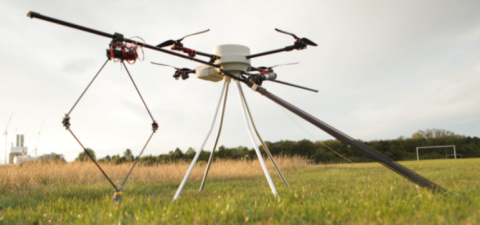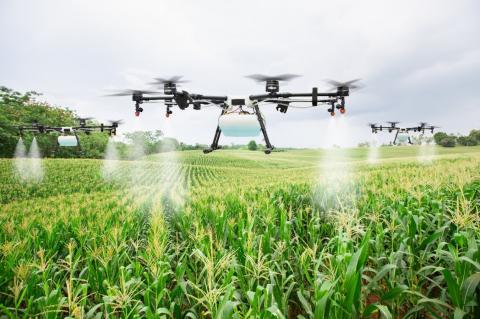15 March 2021
Dr David Cutress: IBERS, Aberystwyth University.
- UAV development and the market for use is continuing to grow
- New regulations and legislations have been put in place which in many instances could facilitate easier use of this technology for farmers
- New platforms are being developed for ease of use by farmers without huge investment costs
Introduction
The UAV industry’s global value is set to increase from £3bn to £30bn in the next 5 years indicating the significance of this technology moving forwards. Previously Farming Connect published an introductory article for the perspective of this technology in agriculture, but with the rapid evolution occurring across UAV use, there are new changes that bear consideration. This article aims to give an update with the changing regulations and legislation in this area so that readers can stay informed if considering implementing this technology. Equally some new concepts and innovations will be highlighted which may be of interest to the sector moving forwards.
Regulation and legislation
As of November 2020, regulations surrounding UAVs from the Civil Aviation Authority (CAA) have changed away from a system differentiating between commercial and recreational flying to a system focused on risk levels of flights. Whilst this could potentially benefit the agriculture sector there are areas where it is, as yet, difficult to ascertain how usage regulations will specifically impact farming, or where some farm systems may be unfairly limited compared to others. The new grading surrounding regulations for drone safety involves three categories of risk with further subcategories within these.
|
1) Open Category |
2) Specific Category |
3) Certified Category |
|
|
|
Within the open category, three further subcategories exist (A1, A2 and A3) for different risk usages essentially based on how close the drone will be flying to people, as well as based on the class (weight/abilities) of the drone being flown (the class list can be in section 3.1 (pg 81) of the following document). Of these, A3 requires no further training or certification and could cover most agricultural imagery-based usages (surveys and mapping etc), however, where these classes may lead to discrepancy is if the agricultural land in question borders more populated areas such as villages, requiring at least A2 Certificate of Competence (A2CofC) training if not General VLOS Certificate (GVC) training and certification. This adds barriers to certain farmers and extra costs to be amassed. Several more innovative applications of drones in farming, for example the use for spraying of pesticides or other chemicals, generally requires heavier weight drones which are penalised for increased risk and require extra costs of training and certification. Interestingly, for farmers interested in more innovative drone use on farms, there is now more consideration in place for extended visual line of sight VLOS (EVLOS) flying where specific GVC accredited flyers (see below) can make use of other visual observers to extend the range that UAVs can be safely flown to avoid collisions. This could be promising for several agricultural aspects to cover larger flight ranges, along with the indication that beyond visual line of sight (BVLOS) flights will be considered further as drone technology progresses.
The legislation is set to change further with the long-awaited ‘Drone bill’ (Air Traffic Management and Unmanned Aircraft Bill) which undertook its 3rd reading on the 28th of January 2021 providing the final opportunity for amendments to be made. Aside from this deadline an independent government specialist group the Regulatory Horizons Council (RHC) have further indicated that UAVs are an area that requires further UK legislation change considerations and in their discussion with the Drone Industry Action Group (Drone IAG) they indicated aims to provide feedback to the government on this later into 2021. Internally, legislation has led to difficulties in applications to European Innovation Partnership EIP) Wales project funding as projects have often been interested in aspects such as flying BVLOS which would make operating safety cases (OSCs) difficult to obtain. Where projects funded by EIP Wales have included UAV use this has been most simple to achieve via sub-contracting to established agricultural drone specialists. Whilst this is equally an option for other farmers in the UK it inherently comes with extra overhead costs compared to buying and running a system yourself.
Training
Training for UAV use, similar to regulations, also revolves around the three-tiered approach.
Training is now provided by CAA ‘Recognised Assessment Entities’ (RAEs) though many are currently still undergoing the transition from previous ‘National Qualified entities’ (NQE).
Innovations
Aside from the UK and global considerations of regulations and legislation, there is a continuous stream of research and development into improved and novel ways to utilise UAVs, either directly in agriculture or through innovation which could have impacts on agriculture. Over the last 5 years, research output in this area has increased 5-fold, with a particular focus in the last year on forestry analysis and plant disease detection areas of UAV use.
1 CropHopper combined UAV and flex legs source – haybeesee.com
One direct agricultural innovation can be seen in the ‘Crophopper’ system design. Their innovative part-drone part-jumping robot sets out to reduce the power consumption linked to constant flight as well as scanning closer to the ground and crop surfaces. This system is designed to cover up to 70 hectares a day autonomously on a single charge roaming a field to assess crop status down to leaf level resolution. Future adaptations suggest its routine surveying could combine well with crop level targeted pest control or fertiliser applications.
Vertical take-off and landing (VTOL) UAVs include rotor-based UAVs like quad or octocopters, however, as noted in the previous UAV article these have certain advantages and disadvantages compared to fixed-wing style UAVs. A potential solution to the compromises between these types of UAVs is the ongoing development into hybrid fixed-wing VTOL UAVs. If such technology is optimised it can allow for longer flight times and higher payload weights with more manoeuvrability. One commercial example from vertical technologies can perform mapping and inspection using a range of onboard sensors and is said to achieve almost 3 hours of flight and 150 km distances with up to a 1.2kg payload on one charge. This compares to rotor-based drones which achieve on average 20 – 30 mins per charge in most systems reducing their possible coverage range.
Hybrid energy sources offer another route to potentially further extend operating times of UAVs for improved field coverage and optimised agricultural implementation. Analysis of combinations of solar and hydrogen fuel cell systems in fixed-wing drones have demonstrated 100% increases in flight time in optimal conditions. Furthermore, experimentation continues into hydrogen systems which supply hydrogen on the go rather than requiring constant refuelling (towards achieving zero-emission targets). Whilst correct development of these technologies could have impacts for all aspects of farm machinery (by retrofitting petrol/diesel engines) UAV specific applications are also ongoing.
Switzerland was the first European country to allow full-scale spraying operations on plants and crops in 2019 but currently, the rest of Europe is lagging, with countries such as the U.S, Canada, China and Australia already legally allowing such operations. UK trials are ongoing to provide evidence towards changing such legislation. Recently expertise of agricultural crop spraying researchers has been offered towards disinfecting COVID-19 hotspot areas via drone spraying, demonstrating possible innovations. This remote, autonomous and targeted spraying of chemicals (even in normally hard to reach areas) is one method to reduce the volume of chemicals applied in agriculture whilst also having benefits to human health by lowering the significantly high pesticide poisoning figures globally.
Recent UAV imagery-based analyses have looked to remotely classify crop growth stages and also to predict the end of season yields from the mid-season analysis to influence ongoing management consideration. Tree and plant disease evaluations have also been areas of interest via various electrical and imaging-based sensors. Skippy Scout is one practical tool in this area which involves a phone app (or offered as an app and drone package combination) created by Drone Ag as a simple automated tool to survey your crops. The app can integrate with basic ~£300 drones to automatically scan crops within a set field for health issues far quicker than ground-based analysis. The platform has been demonstrated to be particularly useful in fighting the major disease spot phoma in oilseed rape which causes £100 million losses each year. Also with the change in focus for farming subsidies surrounding environmental protection inclusive of biodiversity new applications of UAV thermal imagery for assessing surrounding wildlife, including detecting ground-nesting bird sites in fields could prevent destruction via agricultural machinery and could easily be integrated into drones already using thermal technologies on farms.
Utilising edge computing with UAVs (as well as with other precision agriculture technologies) is another application that is undergoing current research. Edge computing aims to provide a local system where data can be created, transferred, processed and packaged rather than relying on internet speeds to send data to central servers or cloud systems. UAV imagery data can involve large file sizes as well as flights large distances away from internet connection platforms, as such utilising onboard edge computing devices (or local devices for shorter range wireless communication) can allow immediate data analysis and decision making as a flyover occurs. Ultimately this technology could make UAVs and other precision systems quicker, more power-efficient, smarter and cheaper if utilised correctly.
Summary
UAV development is happening fast and as such is an area under constant flux. It appears as though regulations and legislations are moving towards increasing freedoms for agricultural-based usages which could help the UK catch up to other countries in this area. However, specific agricultural applications are under-represented in official legislation and codes of conduct. If UAV usage is to be encouraged at a direct farmer level rather than outsourced to select agricultural contractors more advice and transparency on how regulations interact with agriculture specific concerns need to be put in place. Positively we are seeing an increase in growth of agriculture specific UAV training and advice services from agribusinesses in the UK which could help facilitate uptake of a technology which could ultimately help to improve business efficiencies and reduce environmental impacts through a variety of techniques.


